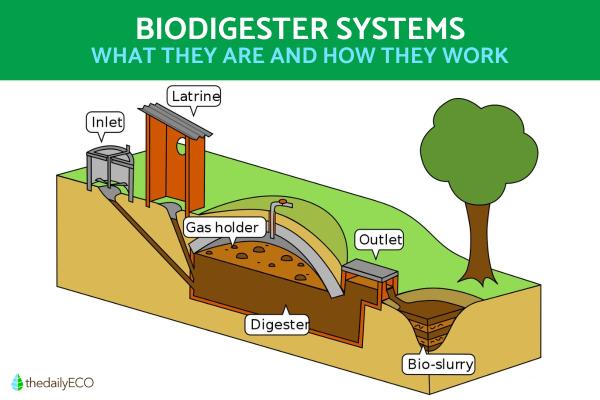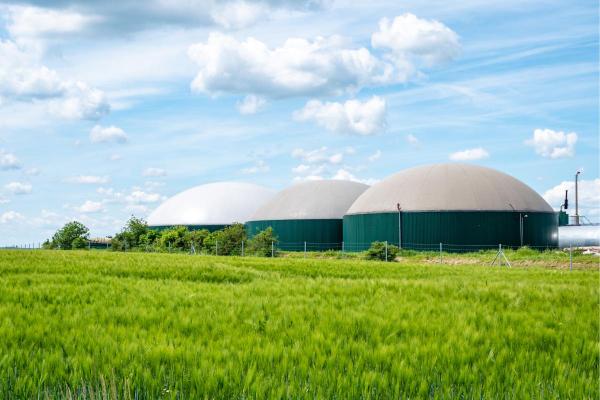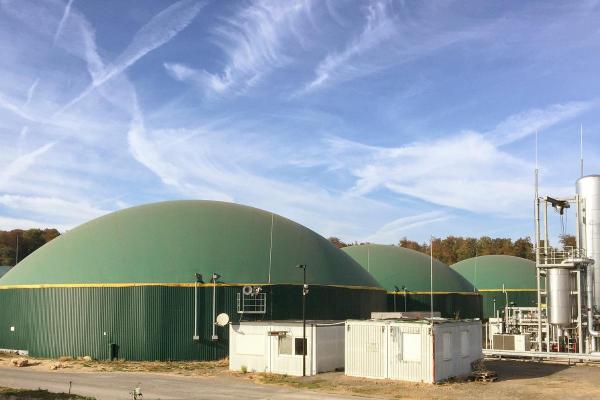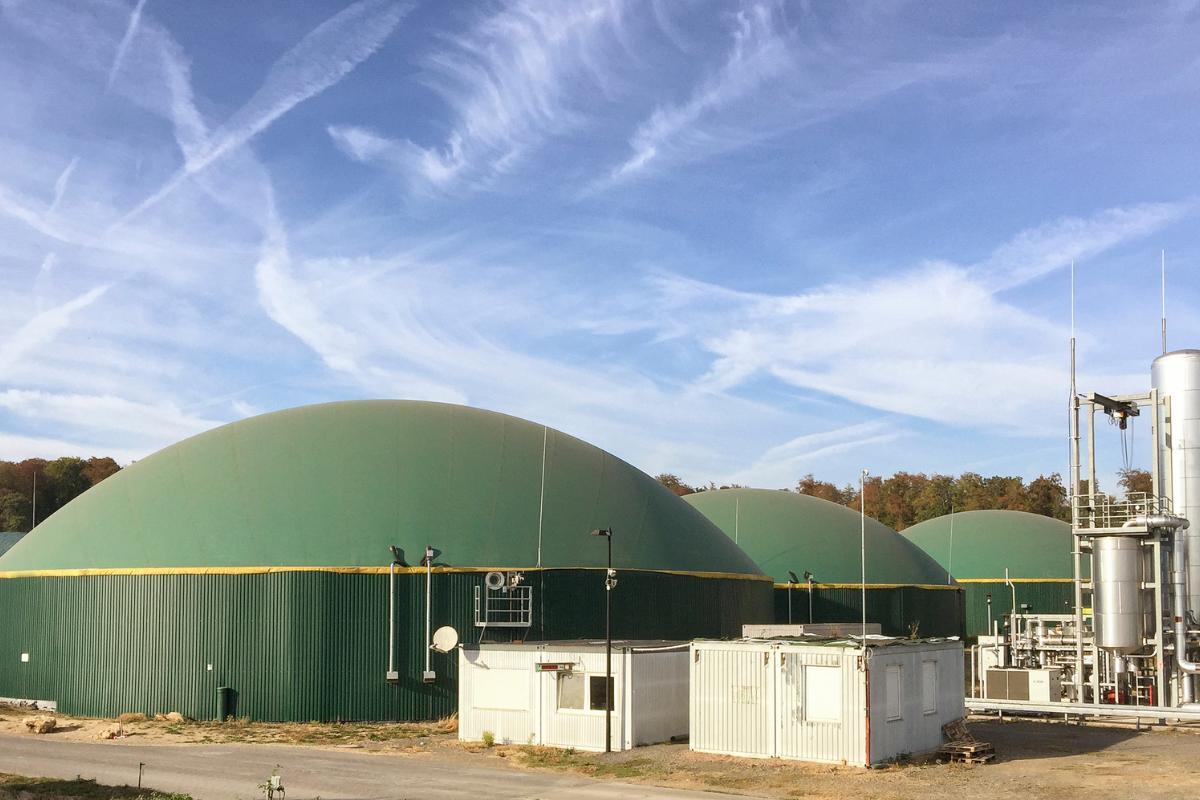What Is a Biodigester and How Does It Work?


Biodigesters are a technology that makes it possible to give organic matter a second chance to generate renewable energy as well as create natural fertilizers. The function of biodigesters is based on the action of microorganisms, especially bacteria. These microorganisms decompose organic matter in the absence of oxygen, a process known as anaerobic digestion. To know more about the function and explanation of biodigester systems, thedailyECO asks what is a biodigester and how does it work?
What is a biodigester?
A biodigester is a system that allows the anaerobic decomposition of organic matter. This is most commonly in the form of plant residues, animal manure, uneaten food and other types of organic waste.
The purpose of the biodigester is to produce biogas and natural fertilizers in the process of getting rid of the organic waste. Biogas consists of a mixture of gases in which methane (CH4) and carbon dioxide (CO2) predominate, as well as other gases such as hydrogen sulfide (H2S). This biogas can be used for cooking, generating electricity or as fuel for vehicles. In this sense, biogas is a type of renewable fuel.
In addition to biogas production, the biodigester also produces a liquid by-product called digestate. Digestate is rich in nutrients and can be used as a natural fertilizer in agriculture.
The process of biodigestion or anaerobic digestion (AD) can be carried out to various degrees[1]. It is an important tool for many commercial enterprises on an industrial scale, but it uses the same biotechnology that can be used at home. Learn more with our article on how to make your own worm castings at home.

How does a biodigester work?
A biodigester system works through a process of anaerobic decomposition of organic matter. This process of anerobic digestion is carried out in the following steps:
- Feeding the biodigester: the first step consists of feeding the biodigester with biodegradable organic matter, such as animal manure, vegetable residues, uneaten food and others. It is important that this matter is well shredded and broken down beforehand to facilitate decomposition and increase the efficiency of the process.
- Anaerobic digestion: once the organic materials are inside the biodigester, an anaerobic environment is created. This is a environment that lacks oxygen. This is possible thanks to the hermetically sealed biodigester apparatus which prevents the entry of oxygen-rich air. The absence of oxygen promotes the activity of bacteria and other anaerobic microorganisms that decompose organic matter.
- Biogas production: during anaerobic decomposition, microorganisms break down organic matter and gases begin to be released. These gases are mainly in the form of methane (CH4) and carbon dioxide (CO2). These gases are collected in the biodigester, forming biogas. Being lighter than air, biogas tends to accumulate in the upper part of the biodigester.
- Storage and use of biogas: the biogas produced can be stored in a suitable tank or storage system. From there, it can be used for various applications such as electricity generation, heating, cooking or even as fuel for vehicles. To use biogas, a driving and control system is required that transports the gas to the devices or systems that use it.
- Digestate Production: during the biodigestion decomposition process, a liquid by-product called digestate is also generated. This material is rich in nutrients and can be used as a natural fertilizer in agriculture.
It is important to highlight that biodigester systems can have different designs and sizes. This is so they can be adapted to the needs and availability of organic materials in each context. In addition, adequate monitoring and control of biodigester parameters is required to ensure an efficient and stable process. These parameters include temperature, pH levels and the organic load (i.e. amount of organic material).

How to make a biodigester
As we have stated, there are various applications for biodigester technology. It is possible to build our own biodigester at home which can be used as a biodigester septic tank. This is able to create homemade biogas. It will require certain materials and basic knowledge to build safely and effectively. For this reason, we provide a guide to building a biodigester tank at home:
The necessary materials to build a biodigester spetic tank at home are:
- A container or tank: it can be a plastic barrel, a water tank or any large and resistant container that can contain organic materials and biogas.
- Pipes: pipes will be needed for the input of organic matter and the output of biogas.
- Valves: to control the flow of materials and gases.
- Hermetic sealant: to ensure that the biodigester is well sealed and prevents gas leakage.
The steps to build the biodigester system are:
- Choosing a suitable container: it must be a container large enough to store the organic materials and the gas. The right material is the one which works for your needs, especially in terms of local climate.
- Prepare the container: make an opening at the top of the container for the input of organic matter and an output on the side for the biogas.
- Prepare the base of the biodigester: dig a hole in the ground deep enough to bury part of the container to maintain a constant temperature and promote the activity of microorganisms.
- Placing the container in the hole: the container should be level and stable in the dug hole.
- Connect the pipes: connect a pipe in the inlet opening of the container to introduce the organic materials. This should be long enough to reach ground level.
- Seal the connections: use hermetic sealant to ensure that the pipe connections are well sealed and prevent leaks.
- Adding organic materials: organic materials are added to the biodigester through the inlet pipe.
- Close the biodigester: place an airtight lid on top of the container and secure it correctly to ensure the anaerobic environment.
- Collect the biogas: with a pipe connected to the gas outlet to collect the biogas that will be generated in the biodigester. This may need a scrubber which uses iron wool to clean the gas of hydrogen sulfide. This is better once it comes to burning the gas.
Collecting the gas from the biodigester system requires a specialized tank which allows the gas to be stored and extracted safely. For this reason, building a home biodigester requires caution and at least basic plumbing knowledge. Consult a professional before trying to create a biodigester at home.
You can see the process of making one type of biodigester in the video below:

Advantages and disadvantages of a biodigester
As we can see, biodigester systems use anaerobic digestion to create useful materials out of organic waste. This can have various advantages, especially in terms of sustainability. However, there are various aspects to consider:
Advantages of a biodigester
- Renewable energy generation: biodigesters produce biogas which is a renewable energy source.
- Reduction of organic waste: biodigesters make it possible to take advantage of organic waste which can otherwise be harmful to the environment. Learn more with our article on types of environmental impact.
- Natural fertilizer: digestate is a liquid by-product of the biodigester process which is rich in nutrients and can be used as a natural fertilizer in agriculture. This can help reduce the reliance on pesticides and synthetic fertilizers which can pollute the soil. Learn more about this topic with our report on the differences between organic and natural food.
- Reduction of greenhouse gas emissions: by capturing and using the biogas produced in the biodigester, the release of methane into the atmosphere is avoided. This helps to reduce greenhouse gas emissions.
Disadvantages of a biodigester
- Requires initial investment: building a biodigester can require a significant initial investment in equipment and materials.
- Requires maintenance and care: biodigesters need proper maintenance and care to ensure optimal performance. They need to be fed regularly and checked for leaks or other problems.
- Need for constant supply of organic matter: for the biodigester to work effectively.
- Limited impact in urban areas: biodigesters are usually more viable in rural areas or areas with a constant supply of organic waste.
Now that you know what a biodigester is and how it works, you should know that the biogas created is not the same as natural gas. Learn more with our article on whether natural gas is a fossil fuel.
If you want to read similar articles to What Is a Biodigester and How Does It Work?, we recommend you visit our Recycling and waste management category.
1. Saha, B., Devi, C., Khwairakpam, M., & Kalamdhad, A. S. (2017). Vermicomposting and anaerobic digestion - viable alternative options for terrestrial weed management - A review. Biotechnology reports (Amsterdam, Netherlands), 17, 70–76.
https://doi.org/10.1016/j.btre.2017.11.005







